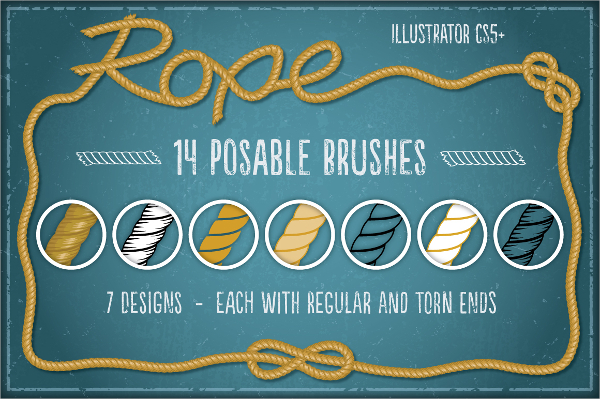Brushes for Adobe Illustrator come in three types; Art Brushes, Pattern Brushes and Scatter Brushes. They’re all used with the Brush tool, but they each have their specific purpose. Art brushes are the most common, they’re applied to paths and are often used to create realistic hand drawn effects. Pattern brushes are configured to generate seamlessly repeating patterns, which help you easily create intricate designs. Finally, Scatter brushes are commonly used to produce grungy shading effects by painting rough textures onto specific areas of your artwork. Illustrator Brushes are rare resources compared to their Photoshop counterparts, so it’s useful to know where to find them. In this post I present 25 great quality Adobe Illustrator brush sets you can download for free!
Check out these great Illustrator Brush products.


• To draw an open path, release the mouse button when the path is the desired shape. • To draw a closed shape, hold down Alt (Windows) or Option (Mac OS) as you drag. The Paintbrush tool displays a small loop. Release the mouse button (but not the Alt or Option key) when you are ready to close the shape.
Illustrator sets down anchor points as you draw. The number of anchor points is determined by the length and complexity of the path and by the Paintbrush tolerance settings. Tip: To adjust the shape of a brushed path after you finish drawing it, first select the path.
Then position the Paintbrush tool on the path, and drag until the path is the desired shape. You can use the technique to extend a brushed path as well as change the shape of the path between the existing end points.
You can create and customize calligraphic, scatter, art, pattern, and bristle brushes depending on your requirement. For scatter, art, and pattern brushes, you must first create the artwork. Follow these guidelines when creating artwork for brushes: • The artwork cannot contain gradients, blends, other brush strokes, mesh objects, bitmap images, graphs, placed files, or masks. • For art and pattern brushes, the artwork cannot contain type. To achieve a brush-stroke effect with type, create an outline of the type and then create a brush with the outline. • For pattern brushes, create up to five pattern tiles (depending on the brush configuration), and add the tiles to the Swatches panel. • To change the options for a brush, double-click the brush in the Brushes panel.
Latest Outlook Import Wizard 5.5 Keygen - Software on this page. Adobe Illustrator blog. Vector portrait which I created using Adobe Illustrator CS5. Adobe Illustrator CC Adobe MAX Brushes creative cloud Creative Cloud. Download free brushes and custom shapes for Adobe Photoshop and Illustrator.
Set the brush options and click OK. If the current document contains brushed paths that use the modified brush, a message appears. Click Apply To Strokes to change pre-existing strokes.
Click Leave Strokes to leave pre-existing strokes unchanged, and apply the modified brush to new strokes only. • To change the artwork used by a scatter, art, or pattern brush, drag the brush into your artwork and make the changes you want. Then Alt‑drag (Windows) or Option-drag (Mac OS) the modified brush onto the original brush in the Brushes panel. • To modify a brushed path without updating the corresponding brush, select the path and click the Options Of Selected Object button in the Brushes panel or select options of selected object from the Brushes panel menu (flyout menu). You can specify different options for the different types of brushes. To change the options for a brush, double-click the brush in the Brushes panel.
Scatter, Art, and Pattern brushes all have identical options for colorization. To customize a stroke instance for Art Brushes or Pattern Brushes, click the Options of Selected Objects icon in the Brushes Panel and set the stroke options. For art brush you can set the stroke width along with flipping, colorization, and overlapping options. For pattern brush, you can set the scaling options along with flipping, fitting, and colorization options. Creates a brush that varies in angle, roundness, or diameter based on the pressure of a drawing stylus. This option is most useful when used with Diameter. It is available only if you have a graphics tablet. Klse Live Stock there.
Enter a value in the Variation box to specify how much more or less than the original value the brush characteristic will vary. For example, when the Roundness value is 75% and the Variation value is 25%, the lightest stroke is 50% and the heaviest stroke is 100%.
The lighter the pressure, the more angular the brush stroke. Uses the key color in the brush artwork, as shown in the Key Color box. (By default, the key color is the most prominent color in the art.) Everything in the brush artwork that is the key color becomes the stroke color.
Other colors in the brush artwork become colors related to the stroke color. Hue Shift maintains black, white, and gray. Choose Hue Shift for brushes that use multiple colors. To change the key color, click the Key Color eyedropper, move the eyedropper to the preview in the dialog box, and click the color you want to use as the key color.